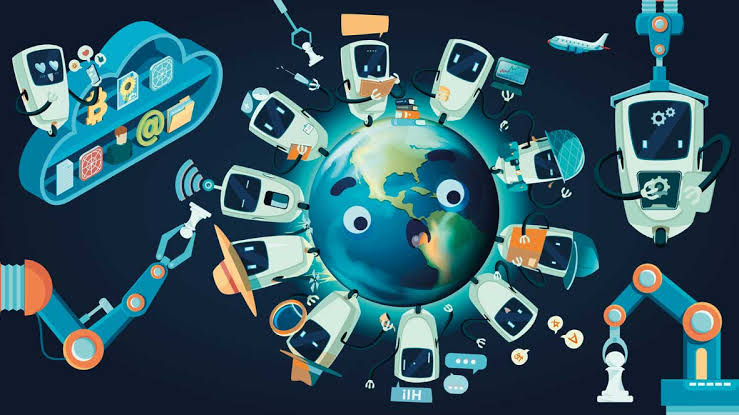Welcome to the era of artificial intelligence advancements, where the impact of AI on human mobility is reshaping the way we work and live. From automation in the transportation industry to AI-driven innovations in travel, the future of transportation with AI is rapidly unfolding before us. As AI revolutionizes human mobility, it is important to explore the role of AI in reshaping travel and its implications for the workforce.
In this article, we will delve into the transformative power of AI, as it displaces human workers and drives advancements in human mobility. We will discuss how AI is changing human travel patterns and revolutionizing the transportation sector, as well as the challenges and ethical considerations that arise. Additionally, we will explore the potential for collaboration between humans and AI to create a more efficient and sustainable mobility ecosystem.
Table of Contents
ToggleKey Takeaways:
- Artificial intelligence advancements are significantly impacting human mobility.
- AI is displacing human workers in various industries, including transportation.
- The future of transportation is being reshaped by AI-driven innovations.
- AI is revolutionizing travel experiences through personalized recommendations and improved navigation systems.
- Advancements in human mobility enabled by AI include intelligent traffic management and AI-powered public transportation systems.
Understanding AI’s Impact on Human Mobility
Artificial intelligence (AI) has made significant advancements in recent years, impacting various aspects of human mobility. From automated systems replacing human workers to the transformation of entire industries, the impact of AI cannot be overstated. In this section, we will explore these advancements and their implications.
One of the key areas where AI is making a profound impact is in displacing human workers. With the development of sophisticated AI systems, tasks that were once performed by humans can now be automated. This has led to concerns about job displacement and the future of work. However, it also presents new opportunities for humans to focus on more complex and creative tasks.
“Artificial intelligence is transforming industries and reshaping the way we work. While it may displace some jobs, it also opens doors for innovation and growth.”
Industries such as transportation are experiencing a significant transformation with the integration of AI. Autonomous vehicles powered by AI technology are changing the way we travel, making it safer, more efficient, and convenient. Traffic management systems that utilize AI algorithms are also improving road conditions and reducing congestion.
Furthermore, AI is reshaping travel patterns and experiences. With AI-powered recommendation systems and virtual assistants, travelers can receive personalized suggestions and assistance, enhancing their overall journey. Navigation systems equipped with AI algorithms provide real-time information and optimize routes to ensure smooth and efficient travel.
In conclusion, artificial intelligence advancements have a profound impact on human mobility. While concerns about job displacement exist, AI also opens up new opportunities and has the potential to transform industries and improve travel experiences. It’s crucial to navigate the integration of AI with careful consideration for ethical implications and collaborate with AI to shape a more efficient and inclusive future of human mobility.
The Future of Transportation with AI
As artificial intelligence continues to advance, it is revolutionizing the transportation sector, shaping the future of how humans travel and interact with their surroundings. From self-driving cars to autonomous vehicles and AI-powered traffic management systems, the integration of AI in transportation is set to have a profound impact on human travel patterns and the industry as a whole.
Self-driving cars and autonomous vehicles:
One of the most significant developments in transportation is the emergence of self-driving cars and autonomous vehicles. With AI technology at their core, these vehicles can navigate roads, make decisions, and operate without the need for human intervention. This advancement in transportation has the potential to improve road safety, reduce traffic congestion, and enhance the overall efficiency of travel.
AI-powered traffic management systems:
In addition to self-driving cars, AI is also being utilized in advanced traffic management systems. These systems leverage AI algorithms to analyze and optimize traffic flow, making real-time adjustments based on data such as traffic volume, congestion patterns, and weather conditions. By dynamically managing traffic signals and routes, AI-powered traffic management systems can reduce travel times, minimize fuel consumption, and enhance the overall experience of commuters.
Implications for human travel patterns:
The integration of AI in transportation has the potential to reshape human travel patterns. With self-driving cars and autonomous vehicles, individuals may rely less on personal car ownership and instead opt for shared mobility services. This shift towards a more efficient and sustainable transportation model could decrease traffic congestion, lower carbon emissions, and enhance accessibility for individuals who cannot drive or own a vehicle.
Furthermore, AI-powered traffic management systems can optimize the flow of traffic, reducing travel times and enhancing the overall efficiency of transportation networks. This could lead to a more seamless and streamlined travel experience for commuters, making public transportation more attractive and feasible for daily commuting.
With the future of transportation being shaped by AI, we can expect significant changes in human travel patterns, leading to a more efficient and sustainable mobility ecosystem.
AI and the Shifting Landscape of Work
In today’s rapidly advancing technological landscape, artificial intelligence (AI) is a driving force behind the automation of various industries, including the transportation industry. As AI continues to evolve, it is displacing human workers and reshaping the labor market in significant ways.
The transportation industry, in particular, is experiencing a profound transformation due to the integration of AI technologies. Automation in the transportation industry has led to the development of self-driving cars, autonomous drones, and intelligent traffic management systems, among other innovations. These advancements are revolutionizing human mobility and changing the way we travel.
With automation taking over certain tasks that were previously performed by humans, there is a growing concern about job displacement. Many industries heavily reliant on manual labor, such as manufacturing and logistics, are seeing the impact of AI-led automation. As AI becomes more sophisticated, it can replace repetitive and routine tasks, leading to a decrease in the demand for human workers in these sectors.
However, while AI may displace certain jobs, it also presents new opportunities for human workers. The development and maintenance of AI systems require a skilled workforce to design, develop, and manage these technologies. The demand for individuals with expertise in AI, data analysis, and programming is on the rise, creating new job prospects in the field of AI-driven technologies.
Moreover, as AI revolutionizes human mobility, new job roles are emerging to support and enhance these advancements. For example, the need for professionals specializing in AI-driven transportation infrastructure design, cybersecurity, and data analysis is increasing. This presents an opportunity for workers to acquire new skills and transition into these emerging roles.
It is important for individuals in the workforce to adapt and acquire the necessary skills to thrive in an AI-driven economy. Companies and educational institutions have a responsibility to provide training and educational programs that equip individuals with the knowledge and expertise required to work alongside AI technologies.
“AI has the potential to automate and streamline certain tasks, but it also creates avenues for innovation and new job opportunities. The key lies in embracing AI as a tool for augmentation and collaboration, rather than fearing it as a threat to human workers.”
The Impact on the Transportation Industry
As AI revolutionizes human mobility, the transportation industry is experiencing significant changes. Here are some key areas where AI is transforming the industry:
| Impact of AI on the Transportation Industry | Description |
|---|---|
| 1. Automation in Vehicles | Self-driving cars and autonomous vehicles are becoming a reality, reducing the need for human drivers and potentially improving road safety. |
| 2. Intelligent Traffic Management | AI-powered traffic management systems can optimize traffic flow, reduce congestion, and enhance transportation efficiency. |
| 3. Enhanced Navigation Systems | AI technologies enable advanced navigation systems that provide real-time traffic updates and personalized route recommendations. |
| 4. Predictive Maintenance | AI algorithms can analyze vehicle data to predict maintenance needs, enhancing the reliability and lifespan of transportation assets. |
AI’s Role in Reshaping Travel Experiences
Artificial Intelligence (AI) is revolutionizing the way humans travel, transforming the entire travel experience. With the power of AI, travel has become more personalized, efficient, and seamless, changing the way people explore the world.
One of the key ways AI is reshaping travel is through personalized travel recommendations. AI algorithms can analyze vast amounts of data, including user preferences, demographics, and historical travel patterns, to provide tailored recommendations for accommodations, activities, and destinations. This level of personalization enhances the travel experience, ensuring that individuals can discover new and exciting places that align with their interests.
In addition to personalized recommendations, AI-powered virtual assistants are becoming increasingly prevalent in the travel industry. These intelligent virtual companions provide real-time assistance to travelers, offering information on flights, hotels, local attractions, and more. Whether it’s answering questions, providing directions, or making reservations, AI virtual assistants streamline the travel process, allowing individuals to navigate unfamiliar territories with ease.
Moreover, AI has significantly improved navigation systems, enhancing human travel patterns. AI-powered mapping and routing applications provide accurate, real-time information on traffic conditions, road closures, and alternate routes. This technology helps travelers optimize their journeys, saving time and reducing congestion on the roads.
“AI is transforming the way humans travel, providing personalized recommendations, virtual assistants, and improved navigation systems.”
A recent development in AI-driven travel is the use of facial recognition technology at airports. This innovative system allows travelers to check-in, go through security, and board flights seamlessly by simply scanning their faces. This eliminates the need for physical documents and speeds up the overall travel process, allowing travelers to spend less time in queues and more time enjoying their destination.
AI also plays a crucial role in enhancing safety and security within the travel industry. AI-powered surveillance systems can analyze video footage to detect suspicious behaviors or objects, ensuring the safety of travelers in airports, train stations, and other transportation hubs.
AI’s advancements in reshaping travel experiences are truly remarkable, and we can expect further innovations in the future. The integration of AI in travel opens up a world of possibilities, making travel more accessible, efficient, and enjoyable for all.
| AI’s Role in Reshaping Travel Experiences | Key Advancements |
|---|---|
| Personalized Travel Recommendations | – Analysis of user preferences and data – Tailored recommendations for accommodations, activities, and destinations |
| AI-powered Virtual Assistants | – Real-time assistance for travelers – Answering questions, providing directions, making reservations |
| Improved Navigation Systems | – AI-powered mapping and routing applications – Real-time traffic information and alternate routes |
| Facial Recognition Technology | – Seamless airport check-in, security, and boarding – Elimination of physical documents |
| Enhanced Safety and Security | – AI-powered surveillance systems – Detection of suspicious behaviors or objects |
AI-driven Advancements in Human Mobility
In recent years, the rise of artificial intelligence (AI) has revolutionized various aspects of human life, including mobility. AI’s ability to analyze vast amounts of data and make intelligent decisions in real-time has opened up new possibilities in the transportation sector, leading to significant advancements in human mobility.
AI-powered Public Transportation Systems
One of the key areas where AI is driving advancements in human mobility is in public transportation systems. AI algorithms can be leveraged to optimize routes, predict demand, and detect patterns that help improve overall efficiency. For example, AI-powered systems can analyze historical ridership data to determine the optimal frequency and capacity of buses or trains, resulting in reduced congestion and improved commuter experiences.
Intelligent Traffic Management
Another area where AI is making a significant impact is in intelligent traffic management. By leveraging real-time data from sensors, cameras, and connected vehicles, AI algorithms can analyze traffic patterns and optimize signal timings to reduce congestion and improve traffic flow. This not only saves time for commuters but also contributes to reducing carbon emissions and making transportation more sustainable.
The Potential for AI to Reduce Congestion and Improve Efficiency
AI’s ability to process and analyze large amounts of data in real-time has the potential to revolutionize urban mobility by reducing congestion and improving overall efficiency. Through AI-powered predictive modeling, traffic planners can anticipate traffic patterns, identify bottlenecks, and implement proactive measures to prevent congestion. Automated systems can dynamically adjust traffic signal timings, reroute vehicles, and manage traffic flows, leading to smoother and more efficient transportation networks.
| Advantages of AI-driven Advancements in Human Mobility | Challenges in Implementing AI-driven Advancements |
|---|---|
| Reduces traffic congestionOptimizes public transportation systemsImproves overall mobility efficiency | Privacy concernsData security challengesTechnical complexities |
As AI continues to advance, it holds immense potential in revolutionizing human mobility. From AI-powered public transportation systems and intelligent traffic management to reducing congestion and improving overall efficiency, the possibilities are endless. However, it is crucial to address challenges such as privacy concerns and data security to ensure the responsible and ethical use of AI in transforming human mobility.
Challenges and Ethical Considerations of AI in Human Mobility
As artificial intelligence continues to make advancements in the field of human mobility, it brings with it a host of challenges and ethical considerations. The impact of AI on human mobility is profound, with both positive and negative implications for individuals and society as a whole.
One of the major concerns surrounding AI in human mobility is privacy. With AI systems collecting and analyzing vast amounts of data, there is a risk of personal information being compromised. Safeguarding privacy becomes crucial in ensuring that AI-driven mobility solutions respect and protect individuals’ rights.
Moreover, bias in AI systems is another critical ethical consideration. AI algorithms are only as unbiased as the data they are trained on. If the training data is biased or unrepresentative, it can lead to discrimination and inequity in access to mobility services. Addressing this bias and ensuring fairness in AI systems is essential to create an inclusive and equitable future of human mobility.
“With great power comes great responsibility.”
– Uncle Ben Parker, Spider-Man
Uncle Ben’s words ring true when it comes to the integration of AI in human mobility. The power of AI to shape and transform our mobility experiences is immense. However, it is essential to approach this power responsibly and ethically, ensuring that AI serves the best interests of humanity.
In order to navigate the challenges and ethical considerations surrounding AI in human mobility, it is crucial to establish robust regulations and guidelines. These frameworks should govern the development, deployment, and usage of AI technology, prioritizing transparency, accountability, and fairness.
Additionally, fostering public dialogue and engagement is vital. Reaching a consensus on the ethical boundaries of AI in human mobility requires input from diverse stakeholders, including policymakers, industry experts, academia, and the general public. By engaging in open discussions, we can collectively shape the future of AI-driven human mobility in a way that aligns with our shared values and aspirations.
Ethical Considerations in AI-driven Human Mobility
| Ethical Consideration | Implications |
|---|---|
| Privacy | Risk of personal information breaches due to data collection and analysis |
| Bias | Potential for discrimination and inequity if AI systems are not unbiased and fair |
| Transparency | AI systems should be transparent about their decision-making processes |
| Accountability | Clear responsibility and liability frameworks for AI-driven mobility solutions |
By addressing these challenges and ethical considerations head-on, we can leverage the advancements in artificial intelligence to create a future of human mobility that is safe, inclusive, and beneficial for all.
Collaborative Future: Humans and AI Working Together
In the rapidly advancing realm of artificial intelligence (AI), the future of human mobility holds exciting possibilities. While there may be concerns about the impact of AI on human jobs and travel patterns, it is important to consider the potential for collaboration between humans and AI in shaping a more efficient, sustainable, and inclusive mobility ecosystem.
By harnessing the power of AI advancements, humans can work alongside intelligent machines to overcome challenges and unlock new opportunities in transportation. This collaboration will not only enhance the capabilities of human workers but also facilitate seamless integration of AI technologies in various aspects of mobility.
Enhancing Efficiency and Sustainability
One of the key benefits of collaboration between humans and AI in the future of transportation is the potential to significantly improve efficiency and sustainability. AI-powered systems can optimize routes and traffic flow, reducing congestion and minimizing travel times. By enabling data-driven decision-making, AI can help identify and address bottlenecks, resulting in smoother, more streamlined mobility.
Moreover, AI can contribute to sustainability efforts by reducing fuel consumption and emissions. Smart systems can optimize energy usage and promote eco-friendly modes of transportation such as electric vehicles. Advanced algorithms can analyze real-time data to support intelligent planning and management of energy resources, leading to a more sustainable and environmentally conscious mobility ecosystem.
Promoting Inclusivity and Accessibility
Collaboration between humans and AI also has profound implications for promoting inclusivity and accessibility in human mobility. AI technologies can empower individuals with disabilities, enabling them to navigate public transportation systems with ease and independence. Through the implementation of AI-driven innovations, transportation networks can become more accessible, accommodating diverse needs and ensuring equal opportunities for all.
Additionally, AI can play a crucial role in bridging transportation gaps in remote or underserved areas. By leveraging data analytics and predictive modeling, AI can help identify areas with limited mobility options and develop tailored solutions to improve connectivity and accessibility, ensuring that no individual or community is left behind.
Building Trust and Acceptance
In order for humans and AI to work together effectively, trust and acceptance are key. It is essential to address concerns regarding job displacement and privacy, ensuring that the integration of AI in human mobility is approached ethically and responsibly. Open communication, transparency, and collaboration between stakeholders, including policymakers, industry leaders, and the public, are crucial to navigate the challenges and build a collective vision for the future of transportation.
By recognizing the potential of AI as a transformative tool rather than a replacement for human workers, we can foster a collaborative future where humans and AI coexist harmoniously, leveraging the strengths of both to create a dynamic and sustainable mobility landscape.
| Benefits of Collaborative Future: Humans and AI Working Together |
|---|
| Enhanced efficiency and optimized traffic flow |
| Promotion of sustainability and reduced environmental impact |
| Inclusivity and accessibility for individuals with disabilities |
| Bridging transportation gaps in remote or underserved areas |
| Establishing trust and acceptance in the integration of AI |
Conclusion
In the ever-evolving landscape of human mobility, artificial intelligence (AI) is playing a transformative role. The advancements in AI are revolutionizing the way we move, work, and experience the world. From reshaping industries to changing travel patterns, AI is driving human mobility advancements that offer both immense opportunities and complex challenges.
As AI continues to progress, we are witnessing the displacement of human workers across various sectors, particularly in the transportation industry where automation is becoming prevalent. This shift raises important questions about the future of work and the skills needed in an AI-driven economy.
Despite the challenges, AI is reshaping travel experiences and transforming transportation systems. Through AI-powered solutions, we are seeing personalized recommendations, virtual assistants, and improved navigation, all aimed at enhancing human mobility and improving efficiency.
As we embrace the potential of AI in reshaping travel and human mobility, it is crucial to navigate these advancements ethically. Considering privacy concerns, potential biases in AI systems, and the overall impact on society is vital in creating a collaborative future where humans and AI work together to create a more inclusive and sustainable mobility ecosystem.
FAQ
How is AI impacting human mobility?
AI is transforming human mobility by revolutionizing transportation, reshaping work, and enhancing travel experiences. It has the potential to automate various industries, displace human workers, and create efficient and personalized travel solutions.
What are the advancements in AI that affect human mobility?
Advancements in AI include self-driving cars, autonomous vehicles, AI-powered traffic management systems, personalized travel recommendations, and improved navigation systems. These advancements aim to improve the efficiency and safety of human mobility.
How does AI impact the future of transportation?
AI is shaping the future of transportation by changing human travel patterns and introducing automation in the transportation industry. This includes self-driving vehicles, smart traffic systems, and efficient public transportation systems driven by AI.
How is AI displacing human workers in the transportation industry?
AI is automating tasks previously performed by humans in the transportation industry, such as driving, logistics, and traffic management. This displacement of human workers creates challenges but also opens up new opportunities for skill development and the creation of new jobs in AI-related fields.
How does AI reshape travel experiences?
AI is transforming travel experiences by providing personalized recommendations, AI-powered virtual assistants, and improved navigation systems. AI enhances convenience and efficiency, allowing travelers to have more seamless and tailored experiences.
What advancements in human mobility are possible because of AI?
AI enables advancements in human mobility, such as AI-powered public transportation systems, intelligent traffic management, and the potential reduction of congestion. These advancements aim to improve overall efficiency and sustainability in transportation.
What challenges and ethical considerations are associated with AI in human mobility?
Some challenges and ethical considerations of AI in human mobility include privacy concerns, potential bias in AI systems, and the need for transparency and fairness in decision-making algorithms. It is crucial to address these concerns to ensure responsible and ethical implementation of AI in human mobility.
How can humans and AI collaborate to shape the future of human mobility?
Collaboration between humans and AI is essential in shaping the future of human mobility. By combining human creativity and critical thinking with the power of AI technology, we can create a more efficient, sustainable, and inclusive mobility ecosystem that benefits both humans and AI.










